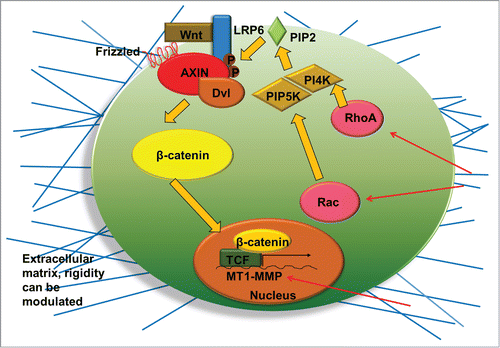Figures & data
Figure 1. Illustration of the interactions of extracellular microenvironment (soluble factors, matrices etc.) with Wnt/β-catenin signaling through biochemical regulation. The effects of Wnt activation (e.g., Wnt 3A or CHIR99021) and inhibition (e.g., DKK1 or IWP4) on pluripotent stem cell (PSC) lineage commitment are shown. GSK-3β: glycogen synthase kinase-3β; TCF: T-cell factor; LEF: lymphoid enhancer factor. FGF, fibroblast growth factor; HGF: Hepatocyte growth factor; IGF: Insulin-like growth factor; TGF, transforming growth factor.

TABLE 1. Summary of the role of Wnt signaling in pluripotent stem cell fate decisions.
TABLE 2. Wnt antagonists and agonists.
Figure 2. Illustration of the interactions of extracellular microenvironment (matrix rigidity, geometry etc.) with Wnt/β-catenin signaling through biophysical regulation. Rigid matrix increases the RhoA and Rac which activate phosphatidylinositol 4-phosphate 5-kinase (PIP5K) and phosphatidylinositol 4-kinase (PI4K). These kinases synthesize the phosphoinositide lipid (PIP2) which enhances Wnt signaling. Rigidity also results in elevated membrane type 1 matrix metalloproteinase (MT1-MMP) expression, a transcriptional target of β-catenin/T-cell factor (TCF), and thereby promotes Wnt signaling. Dvl: Dishevelled.

TABLE 3. Summary of the role of YAP in stem cell fate decisions.
